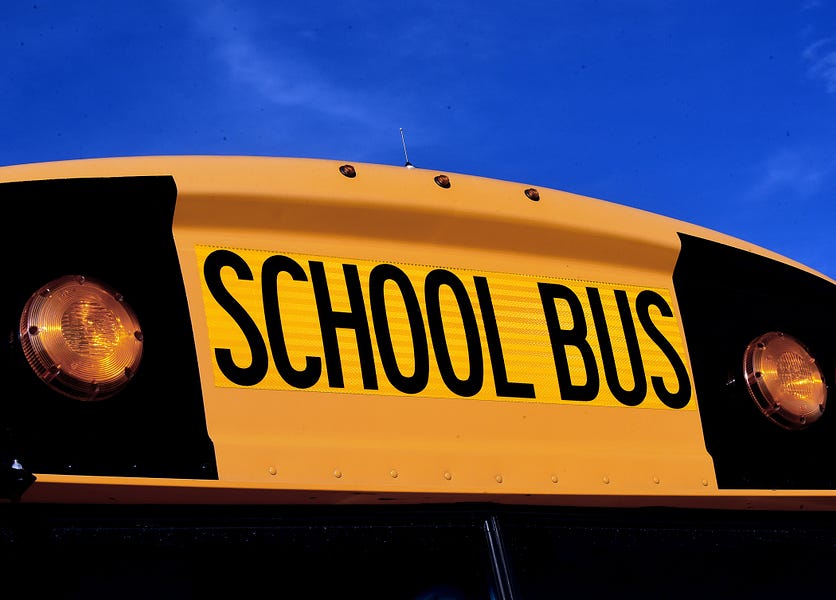As a parent, I’ve always been a little frazzled by the back-to-school routine. When I was growing up, my mom would take me to the nice mall in the next town and we’d have a long day of trying on clothes, going to lunch, and me trying my best to ask nicely when I wanted just a few more things from The Limited or that really cute pair of boots, even though I didn’t need them.
With three boys, it’s more like that game show Supermarket Sweep, but conducted at the Nike store. We’re in and out with new wardrobes in an hour. It’s easier, maybe, but hectic. (And invariably two of them will buy some of the same shirts and shorts but in different sizes, but I’ll save my laundry woes for another installment.) And then I never get to Target for supplies in time, so I stand there cursing that they are out of green folders or blue composition notebooks. And how many %$&@ glue sticks do they need, anyhow?
I’ll never complain about being frazzled again. (Well, at least not for back-to-school prep.)
On Monday, a blissful silence fell over our house a little after 8 a.m., after I walked with our youngest to the bus stop for his first day of sixth grade. Had the circumstances been different, I’d have been a little wistful. It’s his last year at elementary school. Our school really treats the sixth graders well—they have a special play they put on, they take some cool field trips, and the graduation ceremony is simple but really great. I’d have been looking forward to all that awaited him while being a little melancholy that, after 12 years, our family’s time at the school was almost over. No more little kids in our house.
In this case, I still had conflicting feelings, but they were different. Part of it was just pure relief. After some starts and stops–including a text on Friday, Aug. 21 that school would NOT be starting the next Monday–the school year was actually happening. And, for at least for a little while, it would be in person. (Yes, I’m very aware of the debate about whether in-person is worth the risk. We are lucky that so many teachers in our district were enthusiastic about returning. Our oldest is in some AP classes that benefit from in-person instruction, and all of our kids need a little socialization.)
Part of it was gratitude. Our board and administrators worked over the summer to put together separate tracks for families who wanted to be online and families who wanted to attend in person. They had to figure out how to provide socially-distanced busing. They had to figure out how to make lunch safe in a junior high that’s built for 700 and accommodates 1,000. They had to craft class schedules that minimized student traffic in the hallways but provided plenty of time for instruction.
And there were hiccups. Some parents had busing information change at the last minute. Our oldest got placed into Photography II without ever having taken Photography I. But after all we’ve been through, and all the effort it took, those are minor problems.
And of course, part of what I feel is concern. No one wants teachers or cafeteria workers or janitors to get sick. No one wants kids taking home a virus and passing it along to vulnerable parents or grandparents. And what happens if it all gets shut down and we’re back to homeschooling?
One of the nice things though? At least for now, the question, “What did you do at school today?” has yet to be answered with a long sigh and “Nothing.” The kids won’t say they are happy to be back, but at least we get to hear a few more stories about what happened in gym class, or tidbits about something cool they learned.
The year is going to be full of uncertainty. A lot of things—school plays, field trips, even elementary school graduations—probably won’t happen. I’m prepared for pretty much anything. But for now, I’m going to be cautiously optimistic, and here’s why: All summer long, we’ve seen viral videos of angry people harassing grocery-store and retail workers over having to wear masks. Our local Facebook group has been all but ruined over adults complaining about masks, social distancing measures, bars closing early, etc. On Friday, I was talking to some neighbors as the school bus pulled up. Week 1 was almost in the books. I looked up to the windows and in each seat sat a young kid looking out, calmly, wearing a mask like it was no big deal.
It sucks that this is their new normal. But the kids have got this. Let’s hope that we can do right by them.
You might have heard the claims, pushed by QAnon adherents and elevated by President Trump via retweet, that only 6 percent of our pandemic deaths can be attributed only to COVID and 94 percent involve patients who had other conditions. The basis for the claim is a page on the CDC website that explains how “comorbidities” work, and, well, let’s just say it was taken out of context. Fortunately, Dispatch contributor Akino Yamashita is a physician. She patiently and carefully walks readers through the process of filling out a death certificate for a COVID patient, using various hypotheticals. COVID attacks the body in ways that lead to pulmonary embolisms, respiratory distress, and other problems that can lead to death. So even if a patient doesn’t have any of the underlying conditions that we associate with a higher risk of vulnerability, “it would be rare to list only COVID-19 as a cause of death,” Yamashita writes.
Jonah returned from the wilds of the Great Northwest just in time to catch the results of the Massachusetts Senate primary in which progressive Sen. Ed Markey survived a challenge from Rep. Joe Kennedy III. In his midweek (members-only) G-File, he’s amused by Alexandria Ocasio-Cortez’s endorsement of Markey, 74, in which she said, “When it comes to progressive leadership, it’s not your age that counts, it’s the age of your ideas. And Ed Markey is the leader that we need.” What struck his funny bone (or some other nerve)? “These are young ideas? By any measure—and by any label—Medicare for All is not a new idea. Whether you call it socialized medicine, universal health care, social insurance, or M4A, this idea was old not merely when Ocasio-Cortez was born but when Ed Markey was born.” Ah yes, it’s always entertaining when each generation thinks it’s the one that discovered socialism.
It’s been difficult to watch the looting and riots that have followed, and often usurped, the peaceful protests that marked the early days of our summer of reckoning. Imagine watching from home when the business being targeted is your own. Audrey spoke with several business owners whose establishments were damaged or outright destroyed in Kenosha in the riots after police shot Jacob Blake seven times in the back. Pamela Moniz rushed to the scene of the mattress store she and her husband have owned for years after watching a friend of theirs who had worked there being assaulted while trying to fend off protesters. “I understand the people who are passionate to end the inequity between the races, and the people who desperately want change. We need to change. But the people who turn to violence are getting in the way of that message. They’re not letting the necessary message be heard,” Moniz said while holding back tears. In other Kenosha coverage, Christian Schneider reported on the rally held by Jacob Blake’s family at the site of his shooting, an event that coincided with Donald Trump’s visit to meet with law enforcement and tour the damaged areas. If reading the accounts of the business owners who were looted doesn’t get your ire going, well, give Jonah’s column on Vicky Osterweil’s The Defense of Looting a read. Lastly, Jeryl Bier calls out an underreported story that a speaker at an earlier Blake rally made explicit calls for violent retribution.
We know all presidential candidates aren’t much different from seventh-graders running for class president when they’re on the campaign trail. “If you elect me, we’ll have no homework, and ice cream for lunch every day, and we’ll watch movies every Friday afternoon.” But even by those standards, Joe Biden has big spending plans if he wins the White House. Brain Riedl of the Manhattan Institute breaks it down: $1.4 trillion to expand the ACA, $2 trillion on climate change and infrastructure, $1.5 trillion for education. And that’s just the big stuff. Even though he might seem like a moderate compared with some of primary challengers, “Biden’s $11 trillion in new spending is radically far to the left of any Democratic presidential nominee in recent memory—likely back to Lyndon Johnson in 1964.”
And here are a few other things you might have missed:
-
Last month, a massive explosion ripped through Beirut, killing almost 200 people and injuring thousands. Charlotte checks in with an update and explains what French President Emmanuel Macron is trying to do in terms of humanitarian aid and reform for the country riddled by corruption and financial distress.
-
In a members-only French Press, David drills down on the challenge of controlling urban unrest: “Riots and unrest don’t spring forth from healthy communities. Think of a riot as a symptom that makes a disease worse—in the way that a horrible hacking cough can break a rib.”
-
We could all use a little good news, and so we sent Andrew off to find some. He came back with some promising developments on the COVID front. No, we’re not joking.
-
*In The Sweep, Sarah revisits the RNC and actually writes a different speech for President Trump, the one he should have given. If you missed it, go check it out. Her impression is uncanny.
-
Some exciting news: If you haven’t already heard, we’re launching a new newsletter from Scott Lincicome, everyone’s favorite writer on trade policy. This newsletter will be much broader, covering economic policy and trends with an eye towards day-to-day applicability and in language that non-wonks can understand. We’re eager to get it started. Check out his other work for us here, and sign up to receive Capitolism in your inbox here.
-
Finally, the pods: The election is getting closer, and even though political strategists have some PTSD after the surprising results of 2016, the polling seems pretty stable this time around. Sarah and David explain on Advisory Opinions. On the Remnant, Jonah discusses the historic Isreal-UAE deal with Kenneth Pollack. And last but not least, on the Dispatch Podcast, Steve and Sarah have a long conversation with Resurgent creator Erick Erickson, who makes the case for Trump’s re-election while acknowledging his many reservations about the administration.
Photograph by Paul Hennessy/NurPhoto/Getty Images.







Please note that we at The Dispatch hold ourselves, our work, and our commenters to a higher standard than other places on the internet. We welcome comments that foster genuine debate or discussion—including comments critical of us or our work—but responses that include ad hominem attacks on fellow Dispatch members or are intended to stoke fear and anger may be moderated.
With your membership, you only have the ability to comment on The Morning Dispatch articles. Consider upgrading to join the conversation everywhere.